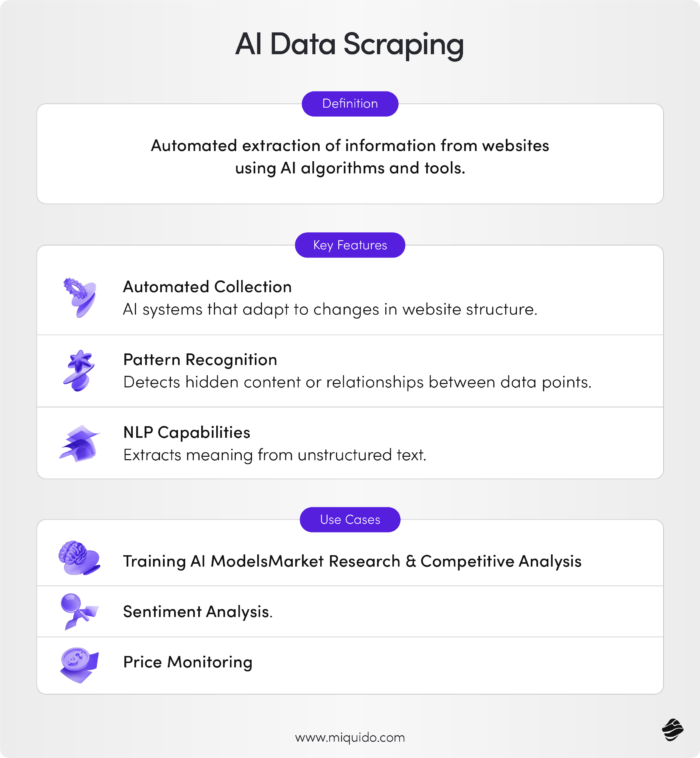- Home
- AI Glossary
- What is AI Data Scraping?


What is AI Data Scraping?
What is AI Data Scraping?
AI Data Scraping
AI data scraping refers to the process of using artificial intelligence to automatically extract large amounts of data from websites or other digital sources. This data is typically unstructured or semi-structured and is gathered to train AI models or feed into machine learning systems for analysis, prediction, or decision-making. AI-powered data scraping tools, also known as AI powered web scraping, are more advanced than traditional web scraping techniques, as they can handle complex tasks like natural language processing, recognizing patterns, or even mimicking human behavior to bypass restrictions on scraping.
In essence, AI data scraping leverages the power of machine learning and automation to collect vast datasets from the web in a more efficient and intelligent manner. This data is often used to improve AI models, enhance business insights, or fuel AI-driven applications like recommendation systems, sentiment analysis, or market trend predictions.
AI Data Scraping Definition
AI data scraping, also known as web scraping, is the automated process of extracting information from websites. It involves collecting data from web pages by identifying specific patterns in the HTML or through APIs. Data scraping can gather a variety of content, including text, images, videos, and metadata, which is then analyzed or stored for various uses.
While it can be done manually, it is usually performed using software tools or scripts that navigate web pages, parse the information, and store it in a structured format, such as a database or spreadsheet. Traditional web scraping methods often involve using programming languages like Python to extract data from websites, but they can struggle with adapting to changes in website design.
Key Aspects of AI Data Scraping
- Automated Collection: AI data scraping tools use algorithms to automate the process of extracting information, saving time and reducing manual labor. AI web scraping enhances the efficiency of data extraction by automating the process and adapting to changes in website structures. Unlike basic scrapers, AI systems can handle larger datasets, make real-time decisions, and adapt to changes in website structures without needing manual reconfiguration.
- Pattern Recognition: AI models can recognize patterns within data, allowing them to scrape not only visible data but also hidden or dynamically generated content. AI models excel at extracting data from complex structures on the web, including hidden or dynamically generated content. For example, AI can detect relationships between data points or extract insights from images, videos, or complex structures on the web.
- Natural Language Processing: AI-based scrapers often use NLP to extract meaning from unstructured text. AI-based web scraping tools often use NLP to extract meaning from unstructured text, capturing context and sentiment from various content types. This enables them to capture context and sentiment from content like reviews, news articles, or social media posts, going beyond mere data collection to deeper analysis.
- Ethical and Legal Considerations: AI data scraping can raise ethical and legal issues, especially when it comes to privacy, intellectual property, and consent. Many websites have terms of service that explicitly prohibit data scraping. AI data scraping tools need to be carefully designed to comply with regulations like GDPR, and to respect the data rights of individuals and organizations.

Use Cases of AI Data Scraping
- Training AI Models: AI systems require vast datasets to improve their accuracy and performance. Data scraping helps collect training data from various sources, such as articles, images, or reviews, which can be used to enhance machine learning models. The extracted data is then used to train and improve machine learning models, enhancing their accuracy and performance.
- Market Research and Competitive Analysis: Companies use AI data scraping to track competitors, analyze market trends, and gather insights on consumer behavior. By analyzing web data, companies can gain insights into market trends and consumer behavior, helping them stay competitive. AI can process large volumes of data from competitor websites, news outlets, and forums to help businesses stay ahead.
- Sentiment Analysis: AI data scraping is often used to gather opinions or sentiments from social media, blogs, and forums. This data can then be analyzed to gauge public opinion on products, brands, or political issues.
- Price Monitoring: E-commerce businesses use AI scraping tools to monitor competitors’ prices, stock levels, and promotions in real-time, allowing them to adjust their own pricing strategies dynamically.
Challenges and Risks of Data Scraping
- Website Restrictions: Many websites have anti-scraping measures, such as CAPTCHA tests or IP blocks. Traditional web scrapers often struggle with these restrictions, but AI-powered solutions are designed to overcome them. AI scrapers can adapt to changes in the structure of a web page, making them more resilient to anti-scraping measures. However, they still face the risk of being blocked or penalized by website owners.
- Legal Implications: Not all data is freely available for scraping. Unauthorized scraping may violate terms of service or intellectual property laws. AI data scraping tools need to navigate these legal frameworks carefully to avoid infringement or penalties.
- Data Quality and Reliability: The data gathered through scraping may not always be accurate or relevant. Ensuring data accuracy is crucial, as inaccurate or outdated information can compromise the effectiveness of AI training. Ensuring that the scraped data is clean, current, and useful for AI training can be a challenge, especially if the source sites have inconsistent or outdated information.
In summary, AI data scraping is a powerful method for collecting vast amounts of data to support AI development, but it comes with technical, legal, and ethical challenges. Understanding what is data scraping and its broader implications is key to responsibly leveraging AI-driven data extraction for tasks like model training, market research, and automated analysis.
Ready to discover more terms?






